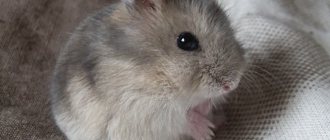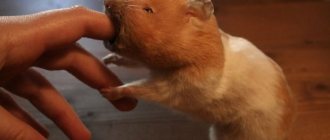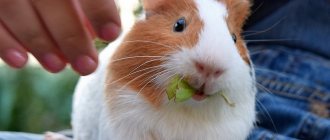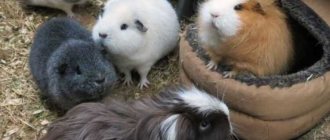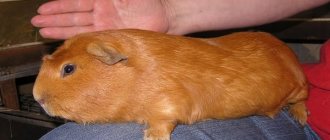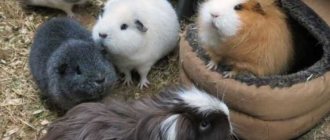Small hamsters attract pet lovers not only with their miniature size. Tiny animals are more active, making them interesting to watch. Such pets are often bought for children. However, dwarf hamsters require careful handling and quality care.
Let's find out how small hamsters of different breeds differ from each other and how to properly care for them.
Dwarf breeds
Different breeds of hamsters are similar in many ways. The body length of these animals most often does not exceed 5–10 cm, and the average weight is about 45–70 grams. Dwarf hamsters live no more than two years. Rodents are quite fragile and need careful handling.
REFERENCE. Externally, all breeds of hamsters are different, but they have a common feature characteristic of this type of rodent: increased activity.
This is the most common variety of dwarf hamster.
Dzungarian
In another way, this breed is affectionately called Dzhungarik. This is the most common variety of dwarf hamster. The length of the rodent's body is no more than 10 cm, and its weight is about 50 g.
The animal has short and thick fur, the color of which is most often gray-brown with a black stripe on the back. The color of the belly is always lighter, and the paws are white on the inside. The rodent has small black eyes that look like beads and a small white muzzle.
Animals living in the wild have the same color. Hamsters have been bred in captivity with more varied coat colors:
- Tangerine (or red), which has a characteristic stripe along the back;
- Gray-blue (or sapphire);
- Pearl (no characteristic stripe on the back).
IMPORTANT! It is better not to keep tangerine (red) hamsters in the same cage for breeding offspring. Such rodents can produce only non-viable cubs.
The animal's face is always light
Roborovsky's hamsters
The breed is called Robos for short. These hamsters bear the name of the scientist who first discovered the animal and described it. China and Mongolia are considered the homeland of rodents, but you can also see them in Russia.
The color of a rodent's skin most often has a platinum tint. But this is not the only option. Variegated, snow-white, agouti and cinnamon varieties are also found. The animal's muzzle is always light, and there is fur on the soles of its paws. The weight of the hamster does not exceed 45 grams, the length of the body is 5-7 cm.
REFERENCE. A distinctive feature of this breed is good immunity. Robos almost does not suffer from diseases.
Taylor's hamster weighs about 60 grams
Taylor's Hamster
Taylor's dwarf hamster has a body length of no more than 8 cm and a weight of about 50-60 grams. The rodent's body and muzzle are elongated, so they look a little like mice. The hamster has small round ears and black beady eyes. The fur is quite thick and short, and has a brown-brown color. The abdomen is light with a dark stripe in the middle.
These hamsters do not change color throughout the year
Campbell's Hamster
The breed got its name thanks to the British Consul, Charles Campbell. He was the first to bring the rodent to Foggy Albion from the Russian-Chinese border. This variety is very similar to Dzungarik, but has its own special characteristics:
- Tousled fur;
- Campbells, unlike Dzungarik, do not change color in the cold season;
- The Campbell's body has a "waist", while the Dzungari's have an egg-shaped body.
Campbell's body is no more than 10 cm long and weighs about 70 grams. The skin can be dyed in the following colors: agouti, albino, opal, argenta, black, fawn, dove, bluish, chocolate, beige or platinum.
REFERENCE. The hamster has a very obstinate and capricious character. He does not like to be held, and tries in every possible way to escape from his owner.
Hamsters need a lot of legumes
Angora
The very name of this species already speaks for itself; fluffy Angora goats, rabbits and cats immediately come to mind. Hamsters differ from them only in size.
Angora hamsters are a variation of their regular Syrian counterparts. Their main distinguishing feature is their rather large size (up to 15 centimeters) and incredibly long, thin fur of a beautiful warm sand color. Branches of the breed with black, white, tortoiseshell, gray, and silver shades of fur were also bred.
This breed has no tail, the front legs are tiny, but the cheeks are very noticeable and large, which adds even more cuteness to this animal.
Allergies to Angora hamsters are quite common (due to their fur). The character is soft. They live on average 2-2.5 years.
What to feed your pet hamster
Nutrition greatly influences the health and life expectancy of a rodent, so the owner must approach this issue especially responsibly and know what can be given to hamsters and what not.
What is possible
Cereals and legumes:
- Peas
- Barley;
- Hercules;
- Millet;
- Corn;
- Lentils.
Protein food:
- Boiled chicken meat;
- River fish and shrimp;
- Boiled chicken eggs.
Fresh vegetables, fruits and herbs:
- Cucumbers;
- Bulgarian pepper;
- Bananas;
- Dill;
- Parsley;
- Chinese salad;
- Apples;
- Pears;
- Grape.
In addition, you can add some nuts to the rodent’s diet, store-bought food, and give a vitamin complex every six months.
What not to do
Hamsters should not be given any exotic fruits, spicy, salty, fatty, peppery, fried or sweet foods. Anything prepared for humans is not suitable for a rodent's diet, so never feed your pet the leftovers of your food.
In addition, hamsters should not be given honey, beets, cabbage, baked goods or pasta. Under no circumstances should you feed your rodent garlic, hot peppers, onions, sorrel, as well as melons, watermelon, apricot or cherry pits, which contain acid that is harmful to your pet.
It is important to properly equip a hamster house
Dzungarian
Along with the Syrian breeds, this breed is also one of the most popular for home use.
Djungarian hamsters rarely grow longer than 5 centimeters; they resemble small fluffy balls, although their fur is not particularly long, rather full. The color is often light sand (in young animals the color is much darker), the ears are tiny, the muzzle is slightly pointed, but does not resemble that of a rat.
Pets rarely cause allergies, they are docile and friendly. They live on average up to 3 years.
Choosing and arranging a home
The cage in which the pet will be is an equally important factor for the comfortable life of a hamster.
Size and material
The rodent cage consists of two parts: a grid and a tray. The grate must be metal so that the hamster cannot chew through it and get out. The pallet is always made of plastic. If you have only one animal, a small cage of 25-30 cm in length and 15-20 cm in height will be enough for him.
The hamster needs enough space, since this animal leads an active lifestyle. If you have more than one pet, try to place them in a large home.
What does a hamster need in a cage?
- Drinking bowl;
- Bowl for food;
- A house in which the animal will sleep.
In addition, be sure to take care of wheels, ladders and other devices with which rodents can be active and satisfy the need for movement.
Don't forget about the bedding, which will create warmth and comfort. The following material is suitable for this:
- Sand;
- Sawdust;
- Hay.
Some people suggest adding cat litter, but if you plan to handle the animal, this may not be the best option.
Have you tried cat litter as bedding for your hamster's house?
The length of teeth and claws must be controlled
Additional accessories
A running wheel for dwarf hamsters has its own requirements: its inner surface must be solid so that the animals do not break their legs on the perforations.
Be sure to install a shelter house. It is better to choose plastic as a material for it. The fact is that wooden surfaces absorb the smell, quickly get wet, and therefore, after a short time it will have to be thrown away.
In addition to the house, you can and should install a “nest”, for example, a small flower pot. Install its top upside down, having previously drilled several holes in the wall. Usually the little ones are happy to make a rookery there from sawdust or scraps of paper.
The ideal option for bedding is sawdust of the middle fraction, in which the animal could burrow and make tunnels for itself. You can also use sifted sand.
Additionally, a tray with sand is also installed - babies love to take dry baths, which helps keep their fur clean. By the way, you should not bathe babies in water - this can lead to hypothermia and death.
How to care for a hamster
Grooming
Decorative hamsters are quite clean and can take care of their skin on their own. For this reason, veterinarians do not advise washing pets unless absolutely necessary. Such a need can only arise if the hamster is very dirty. If you decide to wash a rodent, remember that you cannot wet its head, only wash its body.
Care for claws and teeth
Since hamsters' teeth and claws grow continuously throughout their lives, their length must be monitored. To do this, conduct an inspection once a week. Teeth and claws should be symmetrical, but not too long.
If a hamster's teeth grow to large sizes, the animal will not be able to eat properly and will die of starvation. To prevent this from happening, place tree branches and mineral stones in the cage, on which the hamster can grind his teeth.
If you notice that your pet is not eating and is drooling, there may still be a dental problem and you should take him to the vet.
Once a week you need to completely change the litter
Possible diseases
Dwarf hamsters may have the following diseases:
- conjunctivitis, when the eyes fester, the eyelids stick together;
- diarrhea due to poor diet;
- damage to the cheek pouches from spicy food;
- bite wounds;
- worms;
- improperly growing teeth due to the fact that hamsters are not provided with crackers and twigs for grinding them down;
- cystitis from infection or drafts;
- scabies, which is usually caused by the scabies mite.
For any diseases, you should not treat your hamster with “folk remedies”, but immediately show it to a veterinarian.
When caring for dwarf hamsters, you need to follow this principle: the less stress he has, the longer he will live. You need to train yourself not to raise your voice in the presence of a hamster, not to make sudden movements. Ultimately, you will prolong the life of not only your pet, but also yourself.
Source
Cleaning the cage
To delay the “general” cleaning of the cage, the following actions must be carried out every day:
- remove leftover food;
- Remove feces and any part of the litter soiled by them;
- Remove wet litter.
Once a week, you can completely change the bedding by rinsing the cage tray a little. More thorough cleaning should be done every 2-3 weeks.
IMPORTANT! When cleaning the cage, do not use chemicals. Even a small dose of chemicals can harm your pet's health.
It’s better to buy a pair of different-sex hamsters at once
Brandt
A hamster resembles a cross between a mouse and a rat. The color is fawn-brown, the body is quite long (up to 15-17 centimeters with a tail), the ears are neat, the muzzle is slightly sloping. The wool is stuffed, short, pleasant to the touch.
Allergies to these pets are rare; their character is quite peaceful, with an average life expectancy of 2-3 years.
Peculiarities of reproduction of dwarf hamsters
If you want to breed dwarf hamsters, it is better to immediately buy a pair of pets of different sexes. If you place adult animals with each other, keep in mind that they will need time to get used to each other.
To do this, a partition is placed in the cage that will separate the animals from each other. This way the hamsters will be able to communicate without putting their lives at risk. After some time, the partition needs to be removed and the cage placed in a bright place, which will force the rodents to cuddle together and hide from the bright light.
In the wild, the appropriate time for breeding is from March to September. Pets do not adhere to these time frames and can breed all year round. The female's pregnancy lasts no more than a month.
IMPORTANT! During pregnancy, more protein foods must be added to the rodents' diet. This is important for the normal development of the fetus and the health of the mother. In the first month after the birth of the offspring, the mother also needs a lot of protein. Its absence can lead to cannibalism, when the mother eats her own offspring.
It is worth preparing in advance for the moment of birth. To do this, 3 days before the scheduled date you need to do the following:
- Move the male to another cage;
- Remove wheels, ladders and other entertainment;
- Clean the cage and put more material in the tray from which the female can build a nest;
- Renew the water bowl;
- When labor begins, cover the cage with a dark cloth.
The first 10 days after birth, pets should not be disturbed. If the baby suddenly falls out of the nest, carefully put it back. This can be done with an ordinary spoon, which must first be dipped into the bedding in the place where the hamsters go to the toilet.
Babies are born bald, blind and deaf. But their development occurs quite quickly, and by the tenth day they can see. After 3 weeks, the offspring can already be separated from the mother.
Don't shout around hamsters
Albino
This is not so much a breed as a group of breeds, which can include any hamster born with a special mutation - albinism. Most often in veterinary stores you can find albinos of the Syrian breed, as well as hamsters of the Djungar breed. These individuals retain all the characteristics of their breed and can subsequently produce normal offspring.
The life expectancy of albinos is the same as that of ordinary hamsters of their species. Provided that the pet's maintenance standards are not violated, it will live up to 3 years. Allergies to these pets are rare. The character is soft.
Roborovsky
A dwarf variety of hamsters only 4-5 centimeters long. Cute rodents with funny big ears and very beautiful colors (fawn-pink fur). In addition, you can’t look at these rodents without smiling because of their funny white eyebrows.
This breed is quite social and prefers to live in small groups. Allergies to them are rare. Suitable for children as a first pet. They live up to 2-3 years.
Campbell
A representative of the popular breed of dwarf hamsters (grows up to 10 centimeters, weighs up to 50 grams). It has a rounded small body, sometimes resembling a fluffy ball. Outwardly, it is a little similar to the Dzungarian breed, especially in colors. The most common are individuals with brown-golden fur.
It is considered the most unpretentious hamster for the home, however, if it is not trained, it can grow up wayward. Allergies are quite rare. They live for about 2-3 years.
Radde (Pre-Caucasian, Dagestan)
Outwardly, it looks a little like a Syrian hamster. It is rarely kept as a pet, because it is a large breed. Its length reaches 28 centimeters, and its weight can exceed 800 grams. But despite its impressive dimensions, this is a very pretty creature with silky brown fur, which is diluted with contrasting light inserts.
Rarely cause allergies. They are distinguished by their intractable character and often do not recognize more than one owner. It's better not to have it for children. Raddas live for about 3 years.


